

6/2006
Plenty of award-winning buildings to see while you’re attending the convention in LA

Looking for some architectural sights to see while you’re at the national convention in Los Angeles, June 8–10? Well, do we have some great news for you!
The Los Angeles Business Council (LABC) honored the “best of the breed” of the region’s recent architecture projects on May 17 at its 36th annual Los Angeles Architectural Awards. Nineteen project teams were honored—architects, contractors, and clients who have given the city some of the most innovative projects in the region. Awards were presented in 11 categories: civic, housing, interiors, community impact, landscaping, new buildings, preservation, renovation, sustainability, unbuilt, and mixed-use. To receive an award, projects had to be located within Los Angeles County and completed during 2004 or 2005 (“unbuilt” category exempt). The Getty Villa received the grand prize for designing the newly expanded educational center and museum.
“This year’s award-winning projects exemplify the spirit of the Los Angeles Architectural Awards,” says Wallis Annenberg, vice president of the Annenberg Foundation, a group that focuses on culture and civic life and has a Los Angeles office. “As we continue to rebuild and revitalize Los Angeles, these projects are architecturally remarkable and yet sustainable and affordable.”
Brad Cox, chair of the Los Angeles Business Council and principal of Trammell Crow Company, believes that the Los Angeles Architectural Awards illuminate the most outstanding and important projects in the Los Angeles region. “As part of the Los Angeles Business Council’s mission to improve the quality of life in Los Angeles, the Los Angeles Architectural Awards are recognizing the organizations that are meeting L.A.’s needs for affordable housing, sustainability, and mixed-use development.”
Awards were presented by co-chairs Andy Cohen, executive director of Gensler, and Brooke Lauter, first vice president, corporate communications of Arden Realty. “Constantly raising the bar of design excellence in the Los Angeles community is the mission of this important group of prominent leaders," notes Cohen.
Most winners are available to tour, so bring your city map and walking shoes and make some time to see these great works of architecture.
Public Use
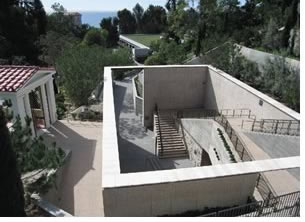 Civic, Grand Prize:
Civic, Grand Prize:
The Getty
Villa, J. Paul Getty Trust, by Machado and Silvetti Associates.
Design of the new expansion of the Getty Villa includes the remodeling
of the existing J. Paul Getty Museum, creating a new home for the Getty’s
permanent collection of antiquities, transforming Getty’s ranch
house into a research facility, and construction of new buildings, public
areas, and gardens. The new architecture transforms the inherent topographical
difficulties into an amenity, allowing visitors to wander through the
lush site, following the contours of the design and terrain, as if experiencing
the drama of an archaeological dig. (If you
go: The Getty Villa, 1200 Getty Center Drive; 310-440-7300; open Thursday–Monday,
10:00 a.m.-5:00 p.m. and closed Tuesday, Wednesday, and major holidays.
Admission is free.)
Civic, Community Impact:
Ashes and Snow, by Gensler.
The Nomadic Museum is a 56,000-square-foot temporary structure housing
Ashes and Snow, an exhibition of large-scale photographic works by
artist Gregory Colbert. The Museum is constructed of 152 steel cargo
containers, the majority of which are rented, while the remainder will
be used to transport the museum as it travels from venue to venue around
the globe. (If you go: Santa Monica Exhibition at the Santa Monica
Pier; 866-308-4203.)
Civic:
Los Angeles Public Library, Hyde
Park—Miriam Matthews Branch,
by Hodgetts + Fung Design and Architecture.
The roots of the design are grounded in traditional cultural forms, but
enlivened by contemporary experiences and tastes, an environment where
the past is at home with the present. This is a building of intense contrasts.
Such a balance between the formal and the informal produces a spatial
and narrative tension that treads a narrow path but lends an almost orchestral “color” to
the experience of the building. (If you go: 2205 Florence Avenue; 323-750-7241;
open until 5:30 p.m.)
Preservation
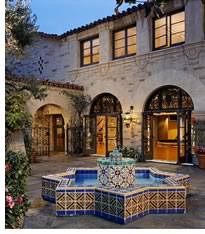 The Geffen Playhouse, by Ronald Frink Architects.
The Geffen Playhouse, by Ronald Frink Architects.
The renovation and expansion of the Geffen Playhouse is an adaptive reuse
of the original structure built in 1929 as a Masonic Club for UCLA. The
building is eligible for the National Register of Historic Places. The
design has very carefully and successfully integrated a contemporary
design of the new program elements with the renovation and preservation
of the warm and romantic character of the Mediterranean Monterey style
of the original building. (If you go: 10886 Le Conte Ave; 310-208-5454.)
Interiors
Haworth–LA Showroom, by Perkins + Will.
Opened in April 2005, this state-of-the-art new space illustrates Haworth’s
commitment to adaptable and sustainable work environments with an emphasis
on human, facility, organization, and business performance. Materials
and messages were carefully selected to create an environment that will
enrich and uplift the human spirit. Haworth’s Los Angeles showroom
was recently awarded the U.S. Green Building Council Leadership in Energy
and Environmental Design—Commercial Interiors™ (USGBC LEED–CI)
Gold Certification. (If you go: The Water Garden 1601 Cloverfield Blvd.,
Santa Monica; 310-481-2300).
The Dimensional Forum, Dimensional Fund
Advisors Inc., by Barton Phelps & Associates.
The Forum is a 7,000-square-foot conference facility on the ground floor
of an ocean-view office building and hosts training symposia for employees
from far-flung offices of a highly successful asset management firm.
Sculptural exuberance in the reception area (an abstraction of an ancient
stone quarry on the Nile) is in marked contrast to the calmly functional,
90-seat auditorium into which it looks through a soundproof glass
partition. (If you go: 1299 Ocean Avenue, Santa Monica; 310-395-8005.)
Housing: Single Family
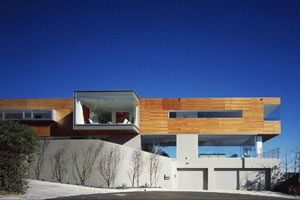 House on Blue Jay Way, by Studio Pali Fekete Architects.
House on Blue Jay Way, by Studio Pali Fekete Architects.
Blue Jay Way represents a beautiful client-architect partnership in design.
Perched on a nearly 45-degree grade, the structure is a four-level, multifaceted
viewing station for the Los Angeles basin. Teak panels clad the upper
level of the house, floating as if on air above an all-glass main level.
A light, open-floor plan emphasizes natural light in every room, and
main program elements are central and low, so as not to block views to
the outside. (If you go: Follow the route
from the Sunset Strip into the Hollywood Hills. This road ends at the
foot of Blue Jay Way.)
Jai House, by Lorcan O’Herlihy Architects.
The house sits on a gently sloping site overlooking the Santa Monica
Mountains. It is a study of the interaction between building and landscape
and celebrates architecture through removal, stripping away visual
and spatial excess, revealing an authenticity of construction and craft.
The building is designed to blur the boundary between landscape and
structure, with, for example, the pool and deck acting as an extension
of the living room. (If you go: Lorcan O’Herlihy can help with
directions, 310-398-0394.)
Views at 270, by M2A Milofsky Michali & Cox Architects.
The Views at 270 was designed in response to a need for a mixed-use project
proposed to provide affordable housing combined with retail use. The
overriding philosophy in the design was primarily that of creating
a sense of community and a sense of place for the residents. The residential
units are organized around the open space as a sort of “village
square” or residential street. (If you go: Located at the corner
of Sunset Boulevard and Western Avenue in Hollywood.)
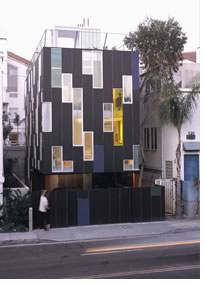 Vertical House, by Lorcan O’Herlihy Architects.
Vertical House, by Lorcan O’Herlihy Architects.
This 2,400-square-foot residence diverges from the pre-established response
to front and back yards by balanced articulation of the skin on all
vertical faces. Most simply, one idea coupled with and realized through
materiality defines the architecture of this residence. The impact
is both powerful and artistic. (If you go:
Lorcan O’Herlihy can
help with directions, 310-398-0394.)
Renovated Buildings
Johnson Fain Studio, by Johnson Fain
Partners.
The new Johnson Fain studio is located in the refurbished Basso Chrysler/Jeep
Dealership Building at 1201 North Broadway overlooking the Cornfields
site, soon destined to become a 17-acre State Park. The one-acre property
combines an automobile showroom, circa 1937; two barrel-vaulted loft
industrial buildings, circa 1924; a single-family dwelling; and a large
parking lot. (If you go: Johnson Fain Partners, 323-224-6000.)
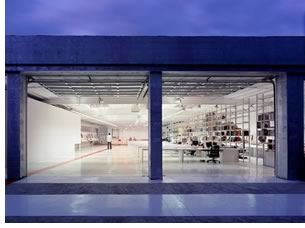 Lehrer Architects Studio, by Lehrer Architects.
Lehrer Architects Studio, by Lehrer Architects.
The dingy, crowded, 5,400-square-foot warehouse was transformed into
a working space of light, air, and transparency where process and product
become one. The visitor is immediately drawn into the architecture—which
is about the beauty of making architecture. Served and servant zones
are explicitly defined. They are visually calibrated to achieve complete
transparency, so that the whole process of making is revealed instantly
upon entry. (If you go: 2140 Hyperion Ave.;
323-664-4747.)
New Buildings
RAND Corporation Headquarters, by DMJM Design.
With the expectations of using the new building on a 24/7 schedule for
another 50 years, aesthetic impact was important to RAND but less so
than functionality and flexibility, support of culture and work style,
and demonstration of both its analytical approach to problem-solving
and its commitment to conservation of natural, client, and intellectual
resources. The RAND Headquarters is an example of a building that uses
an innovative approach to designing for exceptional performance. It received
a U.S. Green Building Council LEED® Gold Level rating. (If you
go: RAND Corporation Headquarters, 1776 Main Street; 310-393-0411.)
Sustainability
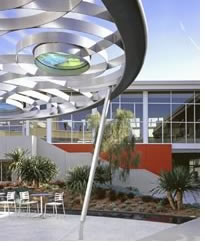 Santa Monica Public Library, by
Moore Ruble Yudell Architects & Planners.
Santa Monica Public Library, by
Moore Ruble Yudell Architects & Planners.
The new Santa Monica Public Library occupies half a city block on the
downtown site of the former Main Library and offers a friendly and service-oriented,
flexible environment with the latest in information technology. Balancing
the need for both public and private spaces was one of the main concerns
in the development of the library’s design. The building received
certified LEED® Silver rating for sustainability. (If
you go: 601 Santa Monica Blvd.; 310-458-8600.)
Mixed-Use, Landscaping
Sunset + Vine, Bond Companies, Nakada & Associates, Inc.
Sunset + Vine was envisioned as a key project in the ongoing revitalization
of Hollywood. The concept creates an urban district plan by providing
street-oriented retail shops along Sunset and Vine Streets with four
levels of residential units above. The residential complex uses a series
of outdoor garden spaces based on the historic tradition of courtyard
housing in Los Angeles.
Sustainability
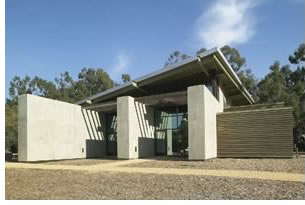 TreePeople
Center for Community Forestry Conference Center, TreePeople,
by Marmol Radziner + Associates.
TreePeople
Center for Community Forestry Conference Center, TreePeople,
by Marmol Radziner + Associates.
Designed for LEED® certification and oriented to make the best
use of the sun and prevailing winds, the TreePeople Conference Center
is one of Los Angeles’ greenest buildings. The TreePeople Conference
Center in California’s Coldwater Canyon Park will be a gathering place
for local, national, and international leaders to create healthy, sustainable
cities. The state-of-the-art conference center also facilitates policy
initiatives and supports innovative partnerships to restore America’s
urban ecosystems. (If you go: Coldwater Canyon
Park Information: 818-753-4600.
—Russell Boniface
Copyright 2006 The American Institute of Architects.
All rights reserved. Home Page ![]()
![]()
![]()